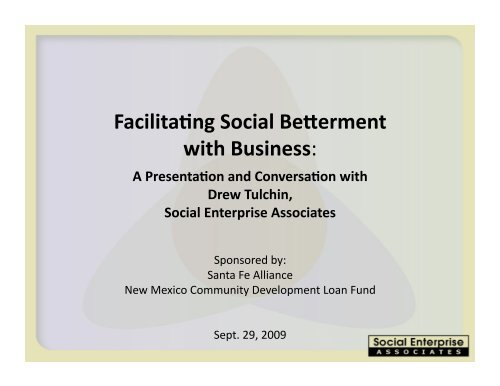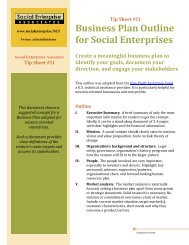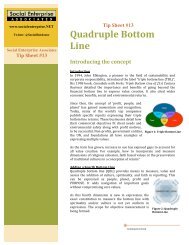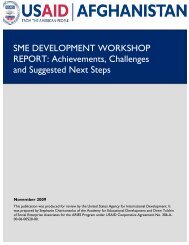Facilitating Social Betterment with Business - Social Enterprise ...
Facilitating Social Betterment with Business - Social Enterprise ...
Facilitating Social Betterment with Business - Social Enterprise ...
Create successful ePaper yourself
Turn your PDF publications into a flip-book with our unique Google optimized e-Paper software.
Facilita'ng <strong>Social</strong> Be/erment <br />
<strong>with</strong> <strong>Business</strong>: <br />
A Presenta'on and Conversa'on <strong>with</strong> <br />
Drew Tulchin, <br />
<strong>Social</strong> <strong>Enterprise</strong> Associates <br />
Sponsored by: <br />
Santa Fe Alliance <br />
New Mexico Community Development Loan Fund <br />
Sept. 29, 2009
Agenda <br />
• IntroducEons & Session ObjecEves <br />
• <strong>Social</strong> <strong>Enterprise</strong> & <strong>Social</strong> <strong>Business</strong> <br />
• New <strong>Business</strong> EnEEes/Structures <br />
• Impact <br />
• Q&A
IntroducEons & <br />
Session ObjecEves
Session Objec'ves <br />
• Discuss <strong>Social</strong> <strong>Enterprise</strong> and <strong>Social</strong> <strong>Business</strong> <br />
• Learn about enEEes that best foster social enterprise <br />
– B CorporaEons, L3Cs, social business, co-‐ops, ESOPs, etc. <br />
• Discuss benefits of these opEons for business; social/<br />
community beTerment <br />
• Explore broader impact of such efforts on society <br />
Ques&ons any&me. Discussion, dialogue preferred.
About You <br />
• Names and organizaEon you are affiliated <strong>with</strong> <br />
• What interests you most about this topic
About Us <br />
<strong>Social</strong> <strong>Enterprise</strong> Associates <br />
Private ConsulEng Firm <br />
A network of professionals <br />
making communiEes beTer by <br />
applying business skills & <br />
sustainable pracEces. <br />
Drew Tulchin, Managing Partner, MBA: <br />
• 13 years relevant professional experience <br />
• WriTen >50 business/strategic plans, raised >$100 mil. cumulaEvely <br />
• Biz plan winner, Global <strong>Social</strong> Venture Comp; Prisma Microfin raised venture $1.2 mil.
Types of Work We Do <br />
Recent Santa Fe Engagements: <br />
• City of Santa Fe, Div of Economic <br />
Development <br />
• Global Center for Cultural <br />
Entrepreneurship (GCCE) <br />
• Regional Development <br />
CorporaEon (RDC) <br />
Other Recent Engagements: <br />
• Environmental Defense Fund, <br />
Mexico <br />
• Microfinance ReporEng Standards <br />
IniEaEve, SEEP Network <br />
• Mississippi IDAs, Hurricane <br />
Affected Miss Coast <br />
• Organic Exchange, TX <br />
• USAID AED/ARIES, Afghanistan <br />
• White Mountain Apache Indian <br />
Tribe (Fort Apache Historic <br />
PreservaEon), AZ <br />
• Women’s OpportuniEes Resource <br />
Center (WORC), PA
<strong>Social</strong> <strong>Enterprise</strong>: <br />
An IntroducEon
Financial Return<br />
For-‐profit vs. Non-‐profit <br />
For-‐Profit <br />
<strong>Social</strong> <br />
<strong>Enterprise</strong> <br />
Non-‐Profit <br />
<strong>Social</strong>/Environmental Return<br />
<strong>Social</strong> <strong>Enterprise</strong>s meld For-Profit & Non-Profit Models<br />
• Mission-driven seeking social and environmental returns<br />
• Not charity, recovers costs from operations through business<br />
• Blended value proposition
Examples Anyone? <br />
Financial Return<br />
Starbucks Examples? Red Cross <br />
<strong>Social</strong>/Environmental Return<br />
Models<br />
• Adapt for-profit model to achieve mission (affordable housing)<br />
• Use business operations to achieve mission, such as employing<br />
disadvantaged people (Goodwill, Rubicon Ventures)
Dr. Muhammad Yunus: <br />
Pioneering <strong>Social</strong> <strong>Business</strong> w/ Microfinance <br />
• Founder, Grameen Bank, Bangladesh <br />
• Recipient, Nobel Peace Prize w/ <br />
Grameen Bank, 2006 <br />
• Mission: To help the poor escape <br />
poverty by lending to them on terms <br />
that allow them to help themselves <br />
• Loan terms: low interest rates, no <br />
collateral, no legal instrument. <br />
Recovery rate: 98%
<strong>Social</strong> <strong>Business</strong> <br />
Author: Crea'ng a World Without Poverty: <br />
<strong>Social</strong> <strong>Business</strong> and the Future of Capitalism (2008) <br />
• <strong>Social</strong> business is not a charity, a non-‐profit or NGO. It is a business in every <br />
sense. It has to recover its full cost while achieving a social objecEve. <br />
• In its organizaEonal structure social businesses are no different from profit-maximizing<br />
businesses. <br />
• The difference is in objecEves. While many have primary goal of profit <br />
maximizaEon for shareholders; social businesses have a primary goal of <br />
creaEng social benefits for those whose lives are touched by it. <br />
-‐ Muhammad Yunus, CreaEng a World Without Poverty
Grameen Network <br />
~30 organizaEons linked to Grameen Bank including: <br />
• Grameen Danone: <br />
– Partnership between Grameen and Danone <br />
– Produces affordable, nutriEous yogurt for malnourished youth <br />
• Grameen Phone: <br />
– Joint venture between Grameen and Telenor <br />
– Leading cellular operator in Bangladesh (>50% market share) <br />
• Grameen Telecom <br />
– Non-‐profit <strong>with</strong> parEal stake in Grameen Phone <br />
– Brings IT to rural people via programming <br />
– Village Phone, its largest program, provides cell-‐phones to rural <br />
poor to support entrepreneurship
New <strong>Business</strong> EnEEes/Structures <br />
for <br />
<strong>Social</strong> <strong>Enterprise</strong>s
B Corpora'ons: B for “Beneficial” <br />
• B CorporaEons: a new kind of company which uses business to <br />
solve social and environmental problems <br />
• To qualify, meet high performance and legal standards regarding <br />
social/environmental work <br />
• Why B CorporaEons are important? <br />
– DisEnguish “good companies” from “good marketers” <br />
– While many companies claim to be green or socially responsible, <br />
B Corps stand out as having real substance behind their claims <br />
– Helpful for employees, consumers, suppliers, investors who want <br />
to support companies making posiEve impact on society
B Corpora'ons: Examples <br />
190 B CorporaEons across 31 industries <br />
<strong>Social</strong> <strong>Enterprise</strong>s Associates: First CerEfied B Corp in NM!
L3Cs <br />
• L3C: Low-‐profit limited liability company <br />
• New legal enEty combining financial advantages of an LLC <br />
<strong>with</strong> social advantages of non-‐profit <br />
- Treated as an LLC for legal and tax purposes <br />
- Must fulfill addiEonal social/environmental requirements <br />
• Purpose / Benefits <br />
- Indicates a clear commitment to social objecEves to investors, <br />
foundaEons and contractors <br />
- Eligible for Program-‐Related Investment (PRI) from foundaEons, <br />
which typically focus on charitable grants <br />
- By aTracEng a wider range of investment sources, L3Cs are more <br />
likely to succeed
Interna'onal Examples <br />
• Bangladesh and Grameen Bank’s examples <br />
• India Sec. 25 designaEon for financial insEtuEons to <br />
allow int’l investors into ‘banks’ that are doing social <br />
value work (a la Grameen Bank). Otherwise, foreign <br />
bank ownership a no-‐no. <br />
• <strong>Business</strong>es that just never made any money. Break-even<br />
proposiEons.
Mul'plier Effect of PRIs <br />
ROI<br />
Financial Return<br />
Investment Tranches<br />
Market Rate Investment<br />
• Market risk and return<br />
(i.e. bonds/stocks 5-7%)<br />
<strong>Social</strong>ly-Conscious Investor<br />
• Risk, non-market return<br />
• Low financial return (3-5%)<br />
<strong>Social</strong> Return<br />
Probability of Success<br />
Foundation PRI<br />
• High-risk<br />
• Minimal financial return (0-3%)<br />
• Retains initial capital<br />
Using PRIs, foundations can play catalyzing role like venture capital.<br />
Early capital matched to risk profile, add’l capital for social enterprises<br />
Source: Marc Lane, <strong>Social</strong> <strong>Enterprise</strong> Alliance
What Other Investment Op'ons Exist? <br />
Primary <br />
Purpose <br />
Investment <br />
Profile <br />
Constraints <br />
Grants <br />
Charitable <br />
Benefit <br />
NegaEve <br />
Financial Return <br />
Program-‐Related <br />
Investment <br />
Charitable Benefit <br />
Minimal Financial <br />
Return (below <br />
market) <br />
“Charitable purposes” must saEsfy IRS <br />
requirements <br />
Mission-‐related <br />
Investment <br />
Financial & <br />
<strong>Social</strong> Benefit <br />
Market or Near <br />
Market Return <br />
Regular <br />
Investment <br />
Financial <br />
Benefit <br />
Maximum Risk-‐<br />
Adjusted <br />
Financial Return <br />
“Jeopardizing investments” are <br />
subject to penalEes <br />
Source: http://www.smallfoundations.org/atf/cf/{C787FF7B-7EF1-45BB-A4C5-0AAD614C9B5F}/SRI%20MRI%20PRI%20lunch.pdf<br />
IRS requires AT LEAST 5% of foundation assets used for “charitable<br />
purposes” annually. Other 95% may be used for mission-related<br />
investing and regular investment
Geography<br />
L3C Challenges <br />
PRI Adoption<br />
Foundations using PRIs<br />
States recognizing L3Cs <br />
Why? <br />
L3C is new legal structure, sEll <br />
spreading. No naEonal <br />
recogniEon, yet. <br />
Why? <br />
IRS requires foundaEons to prove PRIs are <br />
program-‐related; expensive, Eme-consuming.<br />
Bill in Congress to change this. <br />
Source: Community Wealth Ventures
Poten'al L3C Organiza'ons <br />
• Affordable Housing Projects <br />
• Community Development OrganizaEons <br />
• Childcare Centers, Charter Schools <br />
• Health Clinics <br />
• Media Outlets/Newspapers <br />
A poten(al business model for news organiza(ons seeking <br />
alterna(ves to maximize profits or avoiding them <strong>with</strong> non-‐profit <br />
status…The L3C model has bubbled up in discussions about saving <br />
newspapers…and could be relevant to founda(ons commiBed to <br />
helping create and maintain journalism . <br />
-‐ Bill Mitchell, The Poynter Ins(tute
Other Shared Models <br />
Employee Stock Ownership Plan (ESOPs): <br />
CompensaEon system providing employees ownership stake <br />
Ex: W.L. Gore & Associates (makers of Gore-‐Tex) <br />
Worker Co-‐Ops: <br />
Owned, democraEcally controlled by worker-‐owners (1 person = 1 vote) <br />
Ex: Mondragon, Indian Coffee Houses, Grain Distributors in U.S., Water <br />
Credit Unions: <br />
Financial insEtuEon owned, democraEcally controlled by member-‐owners <br />
Ex: Permaculture Credit Union (NM), Navy Federal Credit Union <br />
Company Founda'on: <br />
Charitable foundaEons created by donaEon of company stock <br />
Ex: Entrepreneurship FoundaEon
What do you think? <br />
Implica'ons for Society <br />
• Provide transparency for businesses dedicated to <br />
their stated missions <br />
• Build collecEve voice for social, environmental business <br />
to impact policy-‐making (New Voices of <strong>Business</strong>) <br />
• MulEplier effect leading to addiEonal funds directed to <br />
triple boTom line efforts that provide financial return, <br />
social beTerment, and environmental good
<strong>Business</strong> Planning Fundamentals <br />
Like hygiene, do it b/c you have to, learned behavior, not if want to. <br />
Write it down. Look at it. Revise it. Repeat. <br />
10. Register your enEty <br />
9. Pay taxes, licenses on Eme <br />
8. Know your credit score – personal and business <br />
7. Put assets in business’s name <br />
6. Know your banker by first name <br />
5. Use available financial products, services <br />
4. Hire good staff; pay them an appropriate wage <br />
3. Use an accounEng system <br />
2. Monitor cash flow: get paid fast, Eme bill paying <br />
1. Have system to organize sales, client info – and use it!
Financing 2 Cents <br />
Founda'onal thoughts: <br />
• YOU must be credit-‐worthy <br />
• <strong>Business</strong> needs to document why worth an investment <br />
• If you aren’t willing to put skin in game, why should an investor? <br />
• Be realisEc and know what market based risk costs are <br />
Op'ons: <br />
• BeTer to go to outsiders earlier than later <br />
• Self finance: bootstrap, leverage assets, watch credit card debt <br />
• Friends, Family, Fools – put it in wriEng <strong>with</strong> real docs <br />
• Peer to Peer Lending – cool new opEons, caveat emptor
Marke'ng: Don’t Forget <br />
The 4 P’s: Product, Price, Place (distribuEon), PromoEon <br />
The 5 W’s: Who, What, Where, When, How <br />
Your Customer, Your Reputa'on <br />
• Describe them. Be specific <br />
• QuanEfy them. Find numbers that back you up <br />
• What do they think about you? How do you know? Ask them <br />
Your Compe''on <br />
• There is always compeEEon. Who are they? <br />
• How much do you know? (products, price, customer service, etc.) <br />
Guerrilla Marke'ng <br />
• Lots of cheap ways to get the word out – what’s your best idea? <br />
• Save money: ask for discounts, trade, etc.
Thank you! <br />
Ques'ons? <br />
Answers? <br />
Drew Tulchin <br />
<strong>Social</strong> <strong>Enterprise</strong> Associates <br />
www.socialenterprise.net <br />
drew@socialenterprise.net






